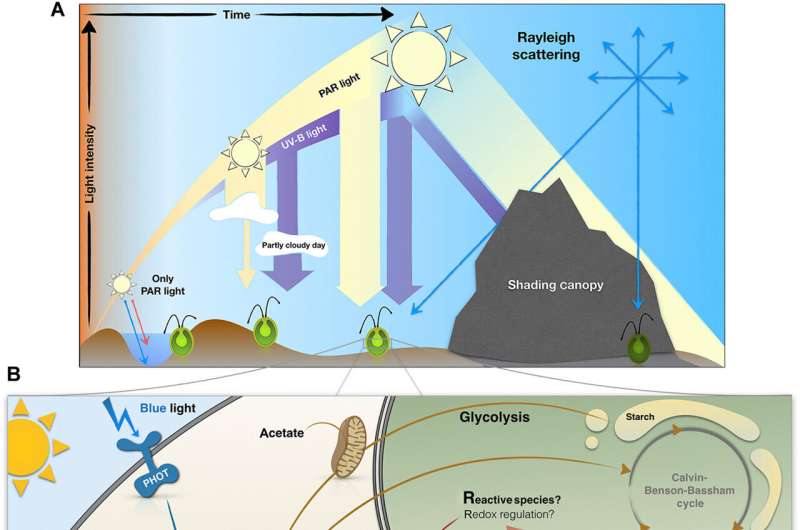'Protective cloak' prevents plants from self-harming in very bright conditions

New work led by Carnegie's Petra Redekop, Emanuel Sanz-Luque, and Arthur Grossman probes the molecular and cellular mechanisms by which plants protect themselves from self-harm. Their findings, published by Science Advances, improve our understanding of one of the most-important biochemical processes on Earth.
Plants, algae, and certain bacteria are capable of converting the sun's energy into chemical energy through a process called photosynthesis. It underpins our entire food chain and is responsible for the oxygen-rich nature of our atmosphere.
"In other words, life as we know it couldn't exist without photosynthesis," Grossman said.
The process takes place in two stages. In the first, light is absorbed and used to synthesize energy molecules, with water a substrate and oxygen as a byproduct. These energy molecules are then used to power the second stage, in which carbon dioxide from the air is fixed into carbon-based sugars.
Photosynthesis occurs when plants—and other organisms capable of it—are exposed to the sun. But in many environments, access to sunlight can shift throughout the day due to wind, weather, clouds, and canopy cover, and other surrounding conditions.
How do photosynthetic organisms deal with this kind of dramatic variability?
"It's necessary for plants and algae to be able to harvest sufficient light when they're in the shade and to dissipate the excess of absorbed energy when light conditions are intense, such as at high noon," explained Redekop.
In extremely bright sunlight, highly reactive oxygen molecules can build up in plants and algae and cause cellular damage, or even death, if they aren't neutralized. To protect themselves from this situation, plants and algae have evolved a set of proteins that can rapidly quench the excess light energy before it can cause too much harm.
Redkop, Sanz-Luque, and Grossman, along with colleagues from CNRS and the University of Grenoble Alpes, characterized the genes that encode these protective proteins in the photosynthetic algae Chlamydomonas and probed the organism's ability to regulate their expression.
"We found that activation of these genes is controlled by an integrated series of signals with built-in redundancies that help plants and algae to optimize their environmental responses depending on the time of day and the surrounding environment," Grossman said.
The team's work focused on the genes that encode three Chlamydomonas proteins known to play a major role in this so-called photoprotection process, revealing a suite of conditions that triggered the genes' activation.
The researchers found that expression of genes encoding these proteins accumulated even in very low levels of light. This is evidence that algae and plants marshal their resources at dawn in preparation for the first few hours of intense morning light.
What's more, the activation of the genes encoding these proteins was induced by the detection of blue light, which increases from dawn to midday and decreases from noon to sunset, especially in aquatic environments. This demonstrates that the system regulating photoprotection is effective in a variety of ecosystems.
The genes are also activated by the presence of UV-B radiation, which is not blocked by cloud cover, allowing algae and plants to track the time of day and prepare for the accompanying changes in light availability, even in low-light conditions.
Last, one of the photoprotection proteins was regulated by the availability of carbon dioxide. The researchers say further analysis is needed to understand this integrated regulatory network.
"Taken together, this set of regulatory features form a protective cloak that dampens the risk posed by excess light in a rapidly changing environmental landscape," concluded Redekop. "This work reveals the stunning array of mechanisms plants and algae have evolved to maintain productivity and minimize harm."
More information: Petra Redekop et al, Transcriptional regulation of photoprotection in dark-to-light transition—More than just a matter of excess light energy, Science Advances (2022). DOI: 10.1126/sciadv.abn1832
Journal information: Science Advances
Provided by Carnegie Institution for Science


















